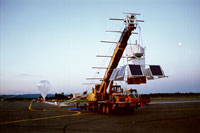|
Introduction
NASA uses balloons to launch scientific
experiments into the upper atmosphere—the edge of space.
Balloons can carry instruments about the size of small cars
to the top of the atmosphere where they can analyze cosmic
rays or view the Sun and stars in new wavelengths invisible
from the surface of Earth.
One of the most fascinating adventure books ever written is,
In Balloon and Bathyscaphe, by Professor Auguste Piccard,
first published in France in 1954. It is the story of building
high-flying balloons and deep diving bathyscaphs (literally
"deep boats") to explore two of the most exotic
locales on Earth—the upper atmosphere and the deep ocean
depths. Piccard recognized that the design of a pressurized
gondola for high-altitude balloon research is similar to a
spherical chamber designed to withstand thousands of pounds
of pressure per square inch when diving deep into the ocean.
It is no coincidence that the captain in Star Trek:
The Next Generation is named Jean Luc Picard. According
to the producer of Star Trek, Captain Picard was named
after Auguste Piccard’s twin brother Jean who also did
pioneering work in scientific ballooning and in exploring
the ocean depths. In 1934, Jean Piccard and his wife Dr. Jeannette
Piccard (a chemist), set a world altitude record when they
piloted their gondola to a height of 57,579 feet (17,550m)
above sea level. Jeannette Piccard became the first woman
to ascend into the stratosphere. The gondola of one of their
balloons is on display at the Chicago Museum of Science and
Industry.
Professor Auguste Piccard and his son, Jacques, designed the
deepest diving submersible (the bathyscaph Trieste 1).
In 1960, Jacques Piccard and U.S. Navy officer Don Walsh piloted
Trieste to the deepest point in the world's oceans.
Interestingly, Trieste has been called a diving balloon,
where lighter–than–water gasoline provides the buoyancy.
Continuing the family tradition, Jacques Piccard’s son
Bertrand has tried more than once an around-the-world non-stop
balloon flight.
Balloons have a long history of use in exploration in science.
Milestones in Exploration with
Balloons
1783
The first balloon with a passenger
rose to the end of a 250-foot tether and stayed aloft, for
15 minutes.
1785
The first balloon flight across
the English Channel.
1793
The first balloon flight in North
America. The launch of this 45–minute flight was witnessed
by George Washington.
1859
French photographer and balloonist
Gaspard Felix Tournachon, also known as Nadar, carried his
bulky cameras aloft to make land surveys from aerial photographs.
1862
The U.S. Army Balloon Corps was
established by President Lincoln. Tethered balloons were used
for reconnaissance during the Civil War.
1912
Viktor Hess took an electroscope
on a balloon ride, to see if radioactivity decreased with
altitude. He discovered that the rate of particles increased
as his elevation got higher indicating that these particles
did not appear to be coming only from the Earth.
1935
The Helium-filled Explorer II balloon
launched near Rapid City, South Dakota carrying Captain Albert
Stevens, Captain Orvil Anderson, and an assortment of instruments
rose to a world record altitude of 22,066 kilometers (72,395
feet). The cameras captured remarkable photographs of South
Dakota and demonstrated the value of reconnaissance from balloons.
Scientific Ballooning Today
Today’s balloons can be over
20 million cubic feet in volume and can carry scientific payloads
that weigh 5,000 pounds to altitudes in excess of 100,000
feet. They provide a less expensive way to launch larger payloads
into a near-space environment.
Balloons have been used for scientific
research in a number of areas. One of the first areas was
in cosmic ray studies, which continue today. Balloons have
also been used to carry instruments for research in the fields
of:
- Gamma Ray and X-Ray Astronomy
- Optical and Ultra-Violet
Astronomy
- Micrometeorite Particles
- Infrared Astronomy
- Magnetospheric Physics
- Atmospheric Sciences
Balloon systems consist of a balloon, a parachute,
and a payload containing instruments to conduct an experiment.
The balloon is inflated with a certain amount of helium, which
expands as the balloon rises. After the experiment is finished,
usually after several hours, a radio signal is given, and
the payload separates from the balloon and is parachuted down,
where it can be reused. The balloon then falls to Earth as
well.
|
|
Inflation of the balloon.
|

|
Close-up of a payload with
scientific equipment hanging from the launch crane. This
payload is for an experiment launched from Fairbanks,
Alaska. |
 |
Launch of a balloon with
a scientific payload from the National Scientific Balloon
Facility at Palestine, Texas. The scientific payload is
hanging from the crane-like device, ready for launch.
|
 |
Launch area at the National
Scientific Balloon Facility. There is a 1000-foot diameter
paved circle for the launch vehicle and balloon layout.
This facility can support two simultaneous launches.
|
 |
Photo of a balloon ascending
at launch with the payload just leaving the ground.
|
 |
Plot of the path of a balloon
launched from Fairbanks, Alaska which circumnavigated
the Earth’s polar region. The balloon passed over
Siberia; near St. Petersburg; Sweden; Iceland; Greenland;
and the northern territories of Canada. |
 |
Scientific payload parachuting
to Earth at the end of a scientific mission. With a soft
landing, the instrument can be used again. |
|